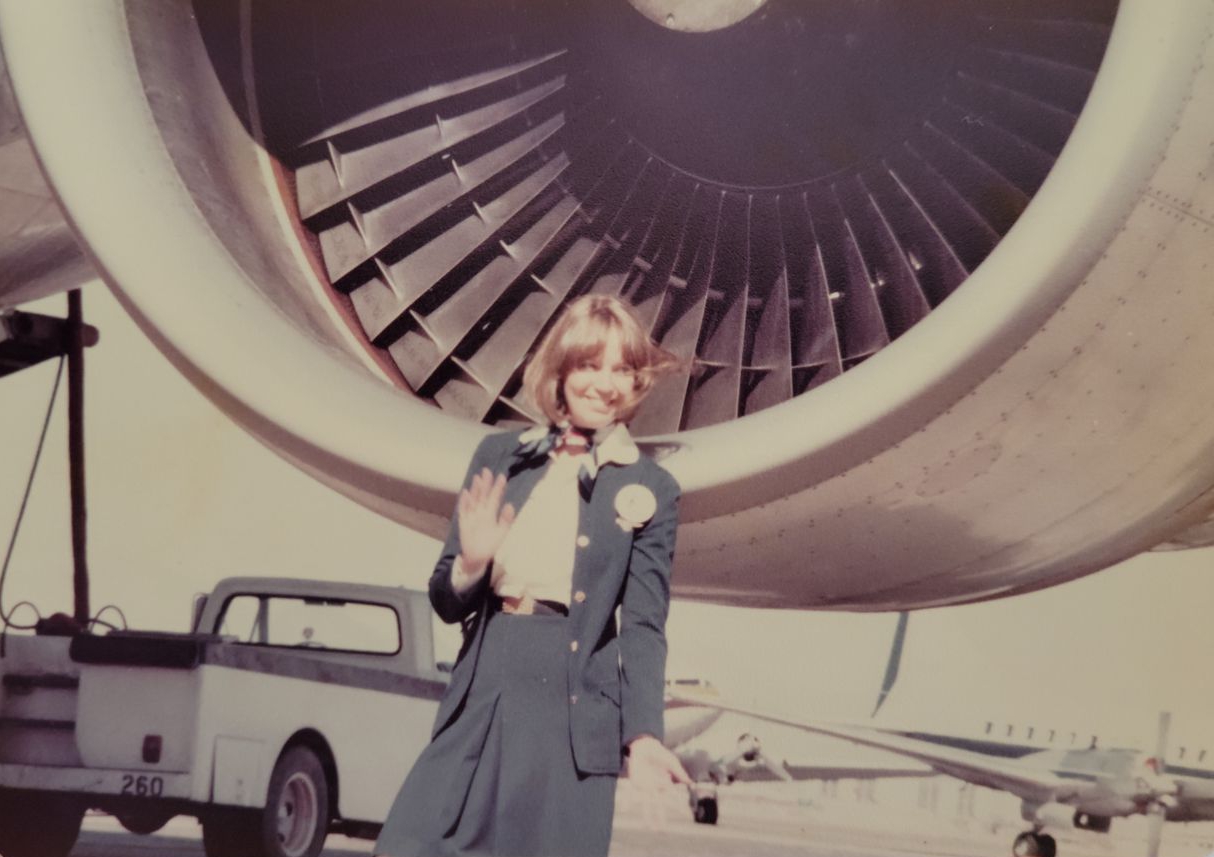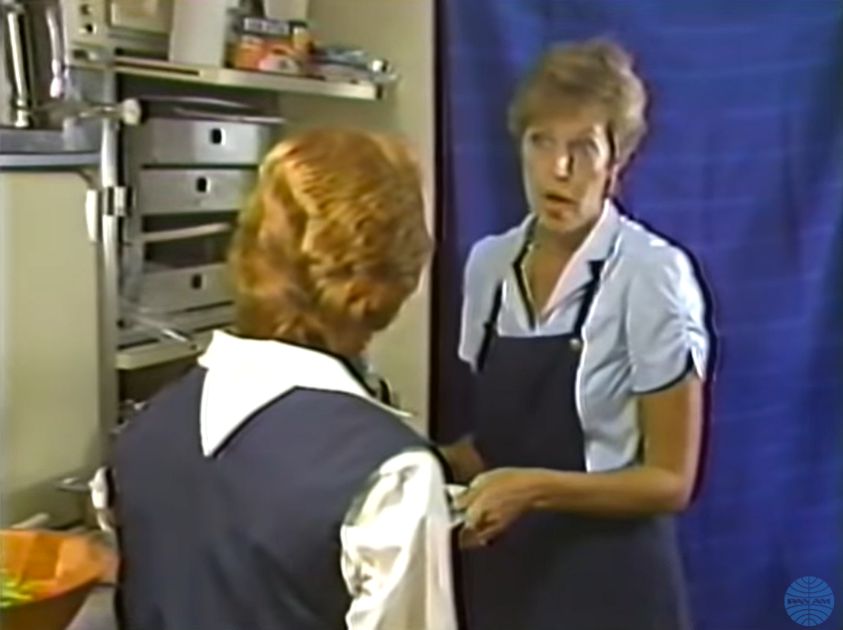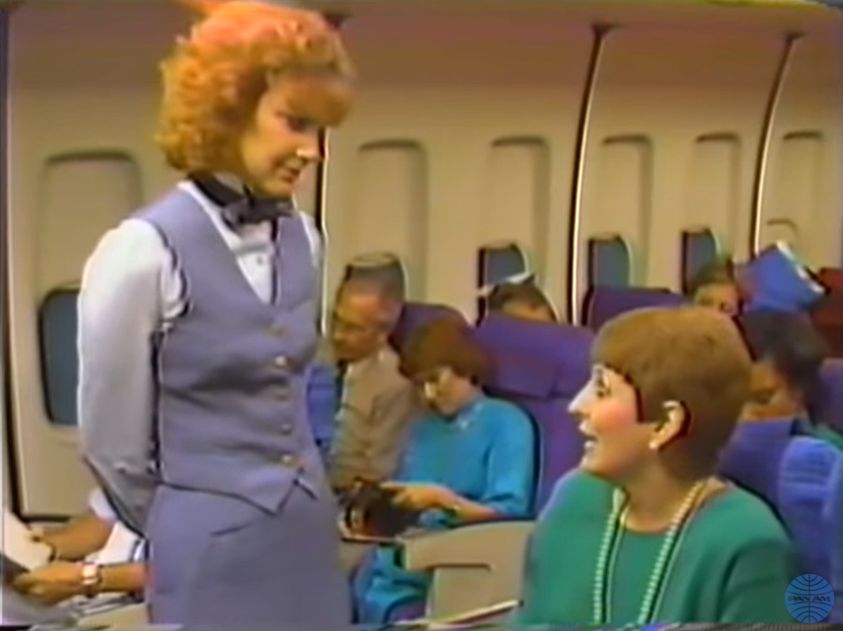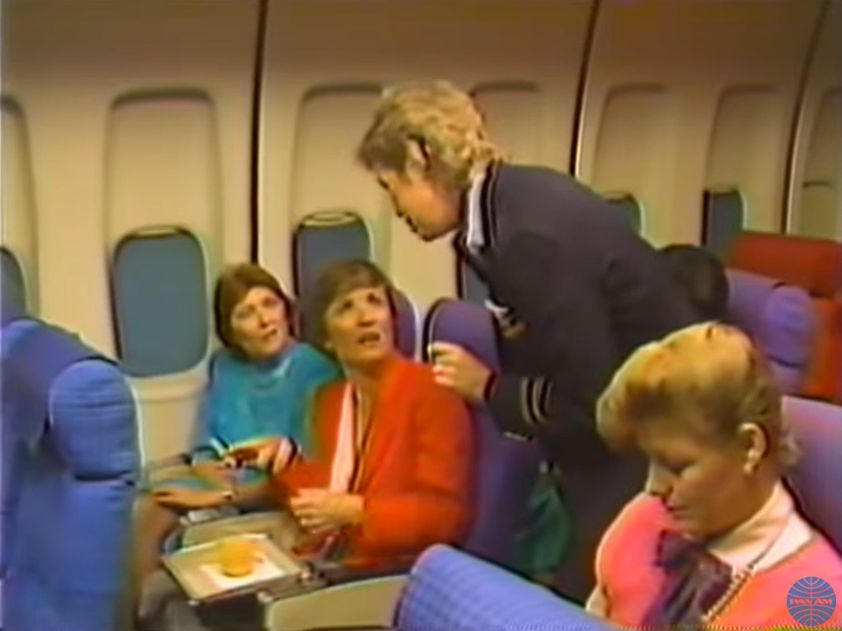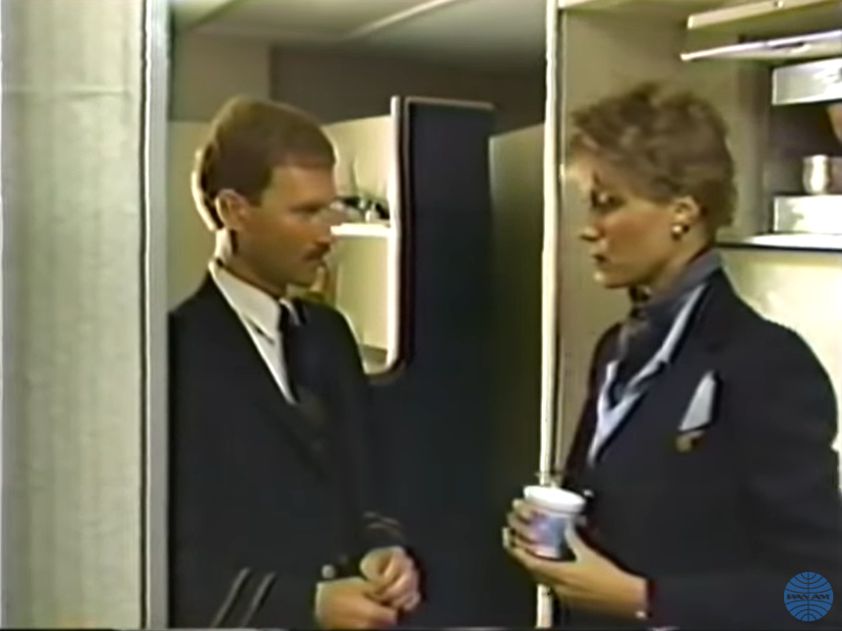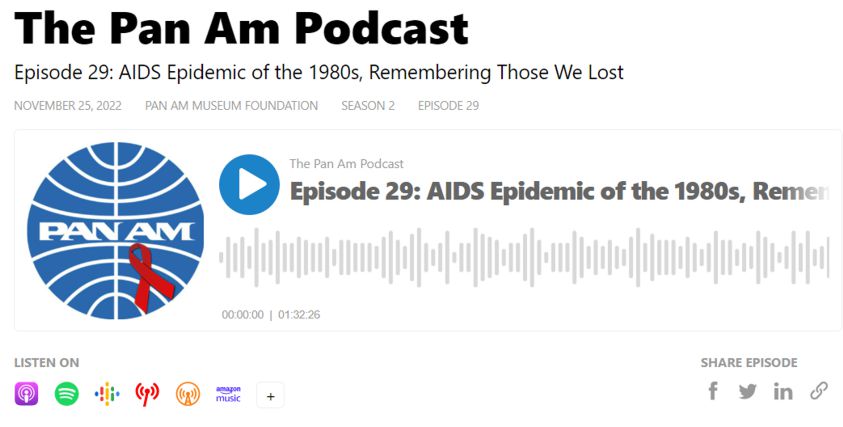A
TIME
…
Learn more about the Pan Am Museum at https://www.thepanammuseum.org/ and explore their fabulous podcast at https://podcast.thepanammuseum.org/.
conducted by on-air personality Annita Thomas (https://www.travelwithannita.com/)
Read the CNN article here: https://www.cnn.com/travel/article/pan-am-flight-attendants-stories/index.html
How did you get into flying with Pan Am?
I had graduated from Indiana University a semester early and had no idea what to do with my future. I had thought about becoming a stewardess, but had not pursued it, and serendipity stepped in. At a Christmas party in Lima, Ohio, a young woman approached me. After a brief chat and confirming that I spoke a second language, she suggested that I apply with Pan Am. Arriving home in DC a few days later, I mentioned it to my mom. She got on the phone, set up an interview, and we were on a flight to New York a few days later. Neither of us had ever been to Manhattan, so we spent the day exploring, and I had a successful interview. The crowning moment was when the interviewer asked me if my parents knew I was applying, and I told him that my mother was just outside. In retrospect, it’s shocking, but it really was a different era.
How long did you work for Pan Am?
I started in 1971 and was there until Pan Am ceased operations in 1991.
How would you describe flying as a PAA flight attendant/stewardess?
I loved it! Flying, back then, was so civilized compared to today. I loved exploring new places and being introduced to new cultures. Traveling the world allowed me to find my independence and learn my strengths. There was no other job like it.
Where were you based during your career? What was it like being based there?
I had never spent time in a large metro area, and I was sent to Chicago out of training. There were six or seven of us sharing an apartment in an old brownstone on Lake Shore Drive. They called it the penthouse, but it was actually an attic with a tiny kitchen and two small bedrooms. Still, it was an exciting new adventure, and even years later, that sense of adventure never waned. Pan Am opened up the world to people like me, and I took full advantage by experiencing flying out of different bases after Chicago: New York, Seattle, San Francisco, Boston, back to New York, and finally Miami. Each base flew different routes: New York had flights to Europe, India, South America, and Africa. San Francisco gave me Asia and Miami frequented South America. Boston and Chicago offered a lot of charter flying to destinations not on the regular route map.
Did you commute or live in your base city? How was commuting to work?
I commuted from Boston to New York after the BOS base closed. Fortunately, it was an easy commute because the Eastern Shuttle ran every hour. As a crew member, you could live wherever you wanted, or needed, to live, and airlines were usually generous with discounted tickets for employees of other airlines. Still, commuting added a considerable amount of time to the workday and could be stressful when there were delays or weather events. Rather than risk missing a flight, I would often drive down from Boston and spend the night with friends in Connecticut before reporting to work the next day.
How did you enjoy the benefits of being a PAA flight attendant?
I traveled as often as I could on my time off. I wanted to seize every opportunity. Some of my fondest memories are from vacations with my mom. She, too, wanted to see everything.
What was your favorite trip? Why?
I loved the Pacific. Europe was fabulous, Africa breath-taking and exotic, but the vastness of the Pacific was thrilling. The Pacific carried the scent of adventure and mystique…places like Tokyo, Hong Kong, and Djakarta were completely different worlds. Quite simply, it spoke to me. We flew to some of the most remote places on the planet, and we flew into Vietnam during the war. There are moments from that time that remain with me today…some that bring a smile and others that bring a tear.
What was your favorite airplane? Why?
Oh, the 747, without question. I started flying when the 747 had only been in service for about a year, and many flights were still on the 707. The 707 had a single aisle and two galleys (one in the front and the other aft) that were about the size of a small closet. Whoever was working the galley would cook and dish up scrambled eggs and Canadian bacon for breakfast for 180-ish people in the back of the plane, or eggs to order in First Class. Imagine the challenge of cooking scrambled eggs in tinfoil pans, in an open-coil oven that was maybe four feet wide and eight inches deep. But the 747, what a majestic and spacious aircraft it was! People could actually get up and move around, a rarity today. This huge beast was so graceful … I could watch it take off and land forever. The 747-SP was my favorite for working. The front galley was tucked away on the side and offered a little privacy for the crew that other galleys did not. And my favorite thing? It had refrigerators!!! OMG!
Did you meet any celebrities, royalty, or well-known or famous people? Tell me about who and how it was to meet them.
I spent nearly an entire night flight from NY to LON chatting with Walter Cronkite. He was exactly what everyone wanted him to be: kind, personable, intelligent, interesting, and a great conversationalist. I liked him immensely. There were many other famous passengers, but that evening stands out.
What special events, projects, or programs were you involved in during your PAA career?
I did a lot of philanthropic and publicity work for Pan Am in Boston, including participating in sports events with local TV news personalities. I held my own in basketball and bicycling (earning the nicknames of Stretch and Spokes), but I was, and still am, abysmal at baseball (where they called me Strikeout). I went on a number of special charters for groups like the Boston Symphony Orchestra. Years later, in Miami, I was chosen to be on the crew that did the proving flight for Pan Am’s first Airbus. Eventually, I took a position in the training department to manage training and curriculum development. I was one of two from headquarters who went to London to close our base after PA sold the London routes to United.
Where were you the day PAA closed? What was your reaction? If you were still flying, how did you get home if you were on a trip?
I felt that first shiver of foreboding when we sold the Pacific to United in 1985. But I remained optimistic and went into management shortly thereafter. I was at the dentist’s office when news of the shutdown came on the television. I called my husband (also PA management) and he confirmed. I cancelled the dentist and drove to MIA. We had a group of flight attendants who just been recalled from layoff and were going through retraining for the “new Pan Am.” I was chosen to deliver the news to them … some of whom had sold homes and were in the process of moving to Miami. It was awful. No, we can’t pay you. No, we can’t get you a ticket home. No, No, No. It was heartbreaking.
What did you do the days after PAA closed? What were you thinking and feeling?
I took a few interviews, but with Pan Am, Eastern, and one of the big banks closing their doors within the previous year, there were few jobs available. I took unemployment and sorted through my options. My husband was on the close-down team and was eventually offered a job with Northwest. We moved to Memphis in late 1992.
If you were still flying on Dec. 4, how did you handle and manage your thoughts and feelings about being unemployed in the days and months following PAA’s closure?
I wasn’t flying at the time… I had been in management for a few years. But I was staggered. Pan Am was my life. My husband’s life. Our income. Our retirement. We lost everything. It was devastating.
Did you work with another airline after PAA closed?
I did some contract work with a couple of start-up airlines, helping with documentation and training. It wasn’t for me. I started looking for other options. Fortunately, I had become fascinated with computers in the early eighties and had acquired quite a bit of skill in that area. I started writing and teaching custom training courses for a couple of computer training centers, and was allowed to sit in a number of classes in high-end programming and administration. Within a year, I had achieved advanced certifications and was designing and programming software for several large corporations. I learned early on, though, never to say I had been a flight attendant…it was almost a stigma, and it was hard enough just being a female in a very male-dominated industry. But I liked programming a lot, and I was good at it, and I was also very adept at identifying the client’s needs. Those skills saved me after Pan Am folded.
What other careers/hobbies did you create for yourself? Are you still doing this work? How did PAA influence your new career?
Programming takes its toll, because you must always stay on the bleeding edge of new technology. I’ve often said that programming is a young person’s game. I still keep my hand in it, up to a point, but I’m not a sharpshooter anymore. I had dabbled with writing throughout my career, so I started writing spy thrillers a few years ago. Pan Am gave me so much knowledge about the world, and introduced me to people in the intelligence and diplomatic communities, and I use all that in my writing.
How do you stay involved and connected to PAA?
I’m on the board of World Wings International, and a member of the Boston chapter. I’m also a member of the Pan Am Historical Foundation and The Pan Am Museum.
Would you do it all again, knowing PAA would go out of business?
Yep. Without hesitation.
Did you meet your spouse or significant other on a PAA flight or layover, or they worked for PAA too?
Yes. On a layover in Dhahran (Saudi Arabia) I met my husband who, at the time, was the Pan Am station manager there.
Have you remained close to other PAA flight attendants? How did you meet? Share a little about your friendship.
Over the years, I’ve remained close friends with a number of flight attendants who worked with me in the PA training department. During COVID, we held regular cocktail meetings over Zoom. These people are bright, witty, creative, fun, and collaborative, and so easy with one another. They are, hands down, the best team I ever worked with.
Where are you traveling to these days?
Headed for the Galapagos in Dec 2023, Antarctica in Dec, 2024 (I hope to wear my PA penguin Tshirt for a photo: “It’s easier to remember where we don’t go.”)
Share how PAA influenced your life.
I can’t begin to enumerate what I learned from my experiences with Pan Am. Stars in the southern hemisphere. Scuba diving in the Caribbean. Awareness of poachers and malaria and malnutrition in Africa. The horror of a devastating earthquake in Mexico City. The Louvre. Caviar and pate. The Forum in Rome. The accuracy of an atomic clock carried in a passenger seat. The humiliation of a quadriplegic brought to the airplane in a catering truck. Champagne. The Grand Bazaar in Istanbul. The deep pain of young men going to war. The joy of families reunited. The cold, hard reality of dictatorships. The platypus at the Taronga Zoo in Sydney. Intricately painted henna on the hands of women at an Indian wedding. Pan Am was more than a job. It was a university unto itself, offering its employees an advanced degree in understanding and appreciation of the incredible world we live in.
What do you miss about PAA?
Life was continuously stimulating … there were always new places to go, new people to meet, new sights to see, and new things to learn. In so many jobs, it’s the same old drag day after day. That was never Pan Am.
Share a fond PAA memory or story that still warms your heart.
The thing that sticks with me is how passengers felt about seeing that big blue ball on the tail of our airplanes. Living or traveling abroad is not always a lark… sometimes the place just explodes in danger. We were always there to evacuate and care for people, during the Vietnam War, or after natural disasters or the overthrow of a government. It was our calling, and we went. I remember people literally kneeling and kissing the floor of the aircraft … their relief was palpable. Pan Am meant “home.”

